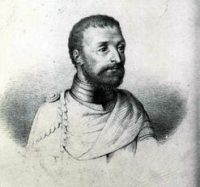[6th April: The fleet departs Limasawa.]
[4th April: Accompanied by Colambu, the expedition leaves for Cebu and heads to Leyte Island: reaches the waters of Canigao (now in Matalom, Leyte)]
[5th April: Sights the terrain of Baybay (Leyte). spends a night in Gatighan (approximately Himokilan, Hindang, Leyte), feasts on a kabog (a megabat), and marvels at the fauna of the place.]
[6th April: [Colambu joins Magellan in the Trinidad in the waters of Pozon (Ponson, now under Pilar, Cebu), Poro (now a Cebu town), and Ticobon (now San Francisco, Cebu).]
De ahí partimos dirigiéndonos al sudeste, pasando en medio de cinco islas llamadas Ceilán, Bohol, Canigán, Baybay y Gatigán, en la última de las cuales vimos murciélagos tan grandes como águilas: uno que matamos lo comimos, habiéndole encontrado sabor de gallina. Existen también palomas, tórtolas, loros y otros pájaros negros, tan grandes como una gallina, que ponen huevos del tamaño de los de patos y que son excelentes para comer. Se nos aseguró que la hembra pone sus huevos en la arena y que el calor del sol bastaba para incubarlos. De Massana a Gatigán hay veinte leguas.
Partimos de Gatigán dejando el cabo al oeste, y como el rey de Massana, que deseaba ser nuestro piloto, no podía seguimos con su piragua, le esperamos cerca de tres islas llamadas Polo, Ticobón y Pozón. Cuando nos hubo alcanzado, lo hicimos pasar a bordo de nuestra nave con algunos de su séquito, lo que le agradó mucho, dirigiéndonos a la isla de Zubu. De Gatigán a Zubu hay quince leguas.
[69] We remained there seven days, after which we laid our course toward the northwest, passing among five islands, namely, Ceylon, Bohol, Canigao, Baybay, and Gatighan. In the last-named island of Gatighan there are bats as large as eagles. As it was late we killed only one of them, which resembled chicken in taste. There are doves, turtledoves, parrots, and certain black birds as large as domestic chickens that have a long tail. The latter birds lay eggs as large as those of a goose, which they bury a cubit beneath the sand for the great heat it generates. When the chicks are hatched, they push up the sand, and come out. Those eggs are good to eat. There is a distance of twenty leagues from Mazaua to Gatighan. We set out westward from Gatighan, but the king of Mazaua could not keep up with us, and, consequently, we awaited him near three islands, namely, Polo, Ticobon, and Ponson. When he caught up with us he was greatly astonished at the rapidity with which we sailed. The captain-general had him come into his ship with several of his chiefs, at which they were pleased; thus did we go to Cebu. From Gatighan to Cebu the distance is fifteen leagues. [Chart VI appears here in original.]
Nanatili kami doon ng pitóng araw, at pagkaraan ay naglayag patúngong hilagang-kanluran, nadaanan ang limang isla; ang Ceylon, Bohol, Canighan, Baybai, at Gatighan. Sa hulíng isla ng Gatighan, may mga paniking sinlaki ng agila. Dahil maggagabi na, pinaslang namin ang isa sa mga ito, na kalasa ng manok. May mga kalapati, tukmol, loro, at mga itim na ibong sinlaki ng domestikadong manok, at may mahahabàng buntot. Nangingitlog ang mga hulíng-nabanggit na ibon ng mga itlog na sinlaki ng gansa, at ibinabaón nilá sa lupa, na siyáng nagbibigay ng labis na init upang pisain ang mga itlog. Pagkapanganak ng mga sisiw, lumalabas silá mula sa mga buhangin. Napakasarap kainin ng mga itlog na ito. May layong dalawampung liga ang Mazaua patúngong Gatighan. Naglayag kami pakanluran mula sa Gatighan, ngunit hindi kami masundan [nang malapítan] ng hari ng Mazaua, kung kayâ naman inantay namin siyá malápit sa tatlong isla; ang Polo, Ticobon, at Pozon. Nang nahabol niya kami, lubos siyáng namangha sa bilis ng aming paglalayag. Pinaakyat siyá ng kapitán-heneral sa barko kasáma ang ilan sa kaniyang mga pinunò, na siyáng ikinatuwa nilá. Sa ganitong paraan kami pumunta sa Zubu mula sa Gatighan, na may layong labinlimang liga mula sa Zubu.
